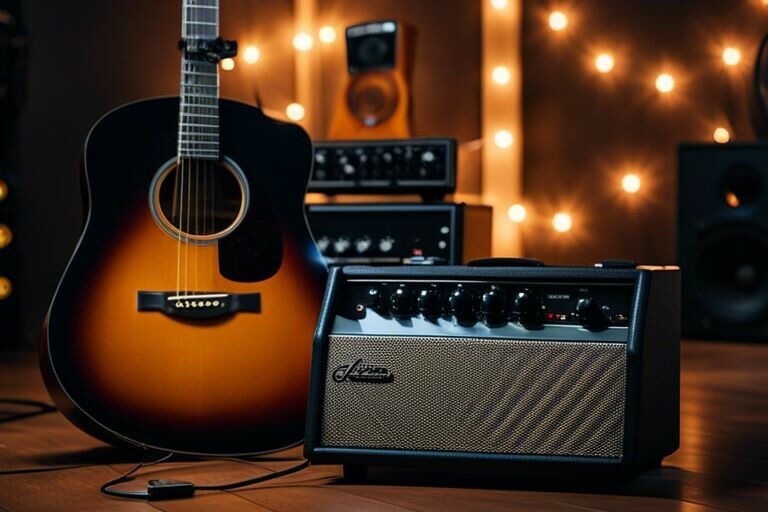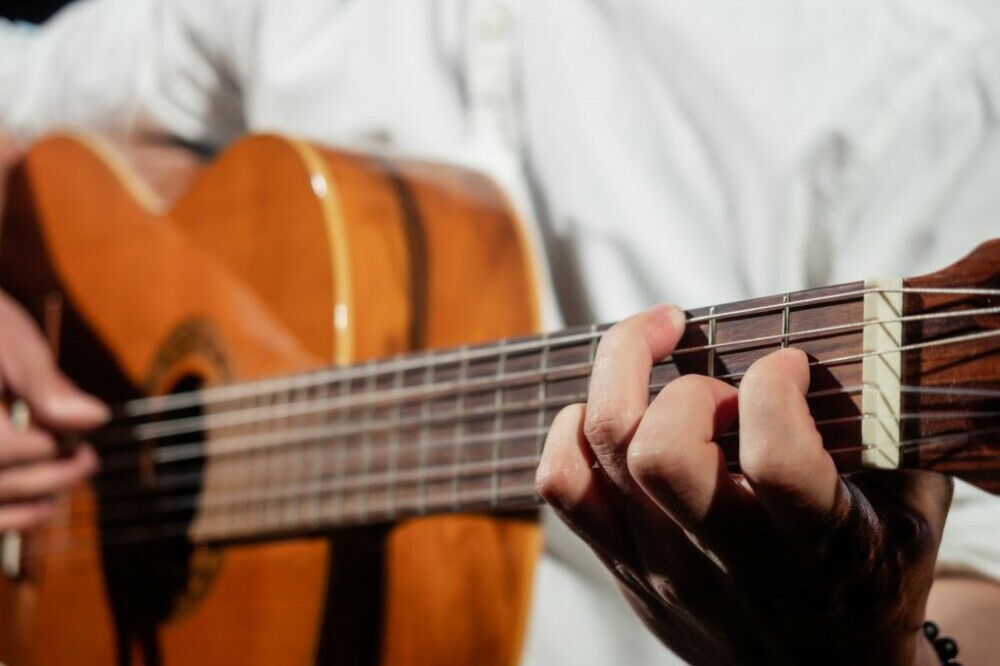
Introduction:
Greetings, fellow guitar enthusiasts! Have you ever wondered how to take your acoustic guitar playing to the next level? Well, look no further than the realm of amps and effects. While acoustic guitars have a beautiful, natural sound all on their own, adding the right amplification and effects can truly transform your playing experience. In this informative post, we will explore the various ways in which you can enhance the sound of your acoustic guitar, from using amps to incorporating different effects to achieve the perfect tone for any performance or recording session.
Here’s a little transparency: Our website contains affiliate links. This means if you click and make a purchase, we may receive a small commission. Don’t worry, there’s no extra cost to you. It’s a simple way you can support our mission to bring you quality content.
Key Takeaways:
- Choosing the right effects: Selecting the appropriate effects for your acoustic guitar can greatly enhance its sound. Experiment with different effects such as reverb, delay, and chorus to find the ones that best complement your playing style.
- Using amp alternatives: While acoustic guitars don’t typically require amplification, using amp alternatives such as acoustic preamps and DI boxes can help shape and enhance the guitar’s sound in a live setting or recording environment.
- Adjusting settings for optimal sound: fine-tune the EQ, volume, and other settings on your effects and amp alternatives to achieve the best possible sound. Pay attention to feedback and unwanted noise, and make adjustments as needed.
Amplification Essentials
Clearly, when it comes to enhancing the sound of your acoustic guitar, amplification is essential. Whether you’re performing live or recording in a studio, the right amplification system can make a significant difference in the quality of your sound.
Understanding Acoustic Amplifiers
Essentials to understanding acoustic amplifiers include knowing the difference between traditional electric guitar amps and acoustic amps. Acoustic amps are specifically designed to accurately reproduce the natural sound of acoustic instruments, without altering their tone. They often have built-in features such as EQ controls, feedback suppression, and effects specifically tailored for acoustic instruments.
When choosing an acoustic amplifier, it’s important to consider the size and power rating that will best suit your needs. Smaller amps are suitable for intimate venues or home practice, while larger amps are better suited for larger venues or outdoor performances. Additionally, some acoustic amps come with built-in DI outputs, making them ideal for connecting directly to a PA system for larger performances.
The Art of Microphone Placement
Essentials to mastering the art of microphone placement involve understanding how the placement of a microphone can drastically alter the sound of your acoustic guitar. Placing the microphone too close to the sound hole can result in boomy and muffled tones, while placing it too far away can lead to a loss of clarity and definition. Experimenting with different placements, such as aiming the mic towards the fretboard or the 12th fret, can help you achieve the desired tones.
Furthermore, using multiple microphones, such as a combination of a condenser and a dynamic mic, can provide a fuller and more balanced sound by capturing different aspects of the instrument’s sound. It’s important to take the time to find the optimal placement for your specific guitar and playing style, as this can greatly impact the overall sound quality of your performance or recording.
Placement of the microphone is crucial in capturing the true essence of your acoustic guitar’s sound. Experiment with different placements and microphone types to find the perfect balance of clarity, warmth, and definition in your sound. The right placement can make all the difference in achieving a professional and captivating acoustic guitar sound.

Pedals and Processors
Any acoustic guitarist who wants to enhance their sound should consider the use of pedals and processors. These devices can add depth, warmth, and dimension to your acoustic sound, taking it to new levels of richness and complexity.
Preamps and EQs: Shaping Your Tone
To shape the tone of your acoustic guitar, preamps and EQs are essential tools. A preamp boosts the signal from your guitar, allowing you to control the overall volume and tone. An EQ (equalizer) is used to tweak the specific frequencies of your sound, allowing you to adjust the bass, mid, and treble frequencies to your liking.
Effects Pedals: Types and Usage
One of the most popular types of effects pedals for acoustic guitarists is the reverb pedal, which adds a sense of space and ambience to your sound. Another essential pedal is the delay pedal, which repeats and echoes your sound, adding depth and texture. Chorus pedals are also commonly used, creating a shimmering, doubled sound. Compression pedals are useful for controlling the dynamic range of your sound, making the softer notes louder and the louder notes softer. EQ pedals allow for additional tonal shaping, while volume pedals give you control over the overall level of your sound. Assume that each pedal serves a specific purpose and can have a significant impact on your acoustic sound.
The reverb pedal can add a sense of space and depth to your sound, giving it a more immersive quality. The delay pedal can create ambiance and texture, while the chorus pedal can add a shimmering, doubled effect to your tone. Compression pedals can control the dynamics of your sound, and EQ pedals allow for precise tonal shaping. Volume pedals give you control over the overall level of your sound, allowing you to seamlessly adjust your volume while performing. The proper usage of these pedals can drastically enhance the quality and expressiveness of your acoustic guitar performance. Importantly, the information should be broken down into a table with 2 columns and 5 rows to provide an overview of the types and usages of effects pedals.
Advanced Sound Enhancement
Keep pushing the boundaries of your acoustic guitar’s sound with these advanced sound enhancement techniques:
- Exploring pickups and transducers
- The role of impedance and signal chain
Exploring Pickups and Transducers
One of the most effective ways to enhance your acoustic guitar’s sound is by experimenting with different pickups and transducers. These devices can capture the natural tone of your guitar and allow you to amplify it with clarity and precision. From piezo pickups to magnetic pickups, there are a variety of options to choose from, each offering its own unique sonic characteristics. By finding the right pickup or transducer for your guitar, you can tailor the sound to your liking and achieve the perfect tone for your performances.
The Role of Impedance and Signal Chain
Signal impedance and the signal chain play crucial roles in determining the quality of your acoustic guitar’s amplified sound. Understanding the impedance of your pickups and the overall signal chain can help you optimize the efficiency and clarity of your signal. By carefully managing impedance matching and signal routing, you can minimize noise and maintain the integrity of your guitar’s natural tone throughout the amplification process.
Role of impedance and signal chain in sound enhancement techniques for acoustic guitar. Understanding impedance matching and signal routing is crucial for optimizing the efficiency and clarity of the signal. By managing these factors, you can minimize noise and maintain the integrity of your guitar’s natural tone throughout the amplification process.

Performance and Maintenance Tips
After enhancing your acoustic guitar with amps and effects, it’s important to focus on performance and maintenance to ensure optimal sound quality and longevity. Here are some tips to help you get the most out of your enhanced acoustic:
- Regularly clean and polish your guitar to keep it looking and sounding its best.
- Check and replace any worn-out strings to maintain a crisp and clear tone.
- Protect your guitar from extreme temperatures and humidity to prevent damage.
- Store your guitar in a safe and secure place when not in use to avoid accidents.
Any enhancements to your acoustic guitar
Optimizing Your Setup for Live Situations
Live performances require careful consideration of your setup to ensure a seamless and dynamic acoustic experience. When preparing for a live performance, consider the following tips to optimize your enhanced acoustic for the venue:
First, make sure your amps and effects are properly configured for the venue and audience size. It’s important to test your setup in advance to avoid any technical difficulties during the performance. Additionally, consider the acoustic properties of the venue and make any necessary adjustments to your setup to ensure optimal sound quality.
Regular Care for Your Enhanced Acoustic
Optimizing the sound of your enhanced acoustic also includes regular care to maintain its quality and performance. Regularly cleaning and inspecting your guitar, as well as staying up to date with string maintenance and storage practices, are essential to preserving the enhancements and ensuring a consistent and pleasing sound.
From Amps To Effects – Enhancing Your Acoustic Guitar’s Sound
With this in mind, it’s clear that the addition of amps and effects can greatly enhance the sound of an acoustic guitar, providing a wide range of tonal possibilities and creative options for musicians. Whether you’re looking to add warmth and depth to your sound with a quality amplifier, or explore the endless sonic potential of effects pedals, there are countless ways to take your acoustic playing to the next level. By experimenting with different gear and settings, you can unlock new dimensions of expressiveness and musicality in your playing, ultimately enriching your overall sound and performance.
FAQ
Q: What are the benefits of using effects pedals with an acoustic guitar?
A: Utilizing effects pedals with an acoustic guitar can greatly enhance its sound by adding warmth, depth, and dimension to the tone. Effects pedals can also allow for creative expression and versatility in playing styles, making the acoustic guitar a more dynamic and engaging instrument to play.
Q: Can any type of effects pedal be used with an acoustic guitar?
A: While many effects pedals are designed for use with electric guitars, there are specific effects pedals that are tailored for acoustic instruments. These pedals are engineered to preserve the natural sound of the acoustic guitar while adding unique effects such as reverb, delay, chorus, and EQ, without compromising its acoustic characteristics.
Q: How can I choose the right effects pedals for my acoustic guitar?
A: When selecting effects pedals for your acoustic guitar, consider the specific sound enhancements you want to achieve. It is crucial to choose pedals that are designed for acoustic instruments and to test different options to find the ones that best complement your playing style and desired sound. Additionally, consulting with experienced musicians or guitar technicians can provide valuable insight into choosing the right effects pedals for your acoustic guitar.
Feel free to share your thoughts, experiences, or questions in the comments below. Whether you’re a seasoned player or just beginning your musical journey, your insights can inspire and connect with fellow enthusiasts.
==> Create a Test Drive Account at Wealthy Affiliate Now (It’s Free)
w: acousticguitarguru.com
e: mailto:billy@acousticguitarguru.com
